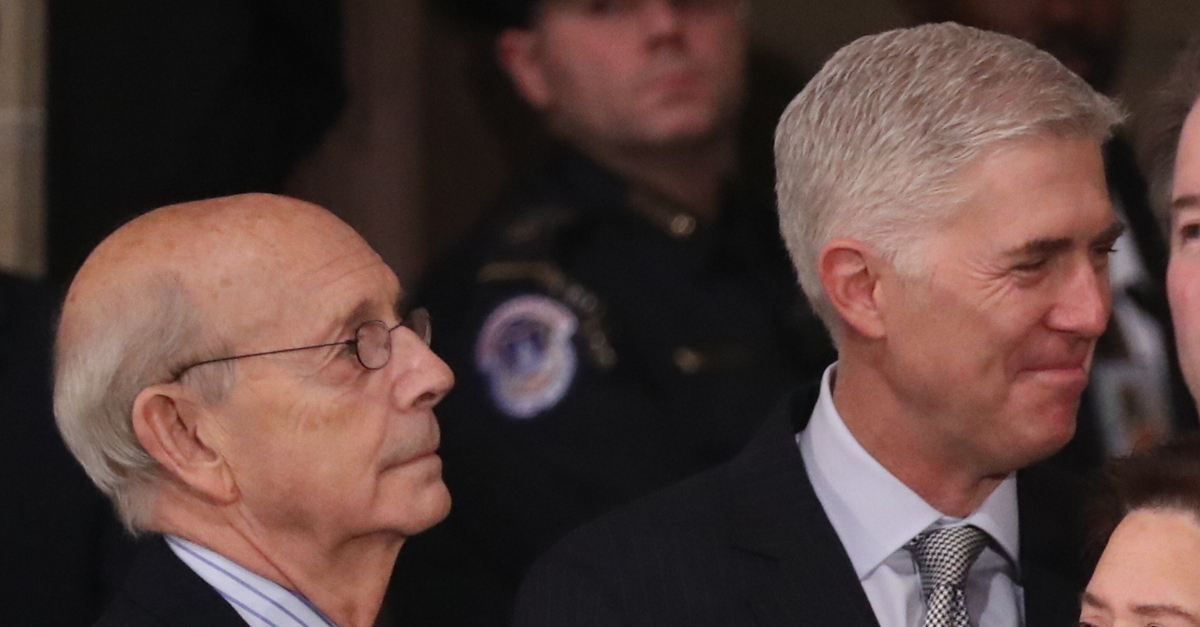
Associate Justices of the Supreme Court of the United States Stephen Breyer (L) and Neil Gorsuch (R).
Tuesday’s oral arguments at the Supreme Court have now lost another in-person participant, prompting speculation that the absences of two justices were a direct reaction to Justice Neil Gorsuch’s refusal to wear a mask while on the bench.
Justice Stephen Breyer, 83, and 67-year-old Justice Sonia Sotomayor (who has had Type 1 diabetes since childhood) dialed into the proceedings from their chambers. Sotomayor, once the sole justice who wore a mask on the bench, has been participating remotely since the start of the current term. Breyer, who had been present in the courtroom on Monday, opted to participate remotely Tuesday. Later on in the day it was reported that Breyer actually isolated out of an “abundance of caution” after a false positive COVID test.
NEW: Breyer received false-positive rapid Covid test today, Supreme Court says. He has subsequently gotten negative result on second rapid test and PCR test taken this morning. Remote participation today out of “abundance of caution.”
— Greg Stohr (@GregStohr) January 11, 2022
Earlier in the day, chatter and speculation abounded about Sotomayor and Breyer’s remote work at SCOTUS.
Justice Breyer is 83, and Justice Sotomayor has juvenile diabetes.
And Neil Gorsuch is …, well, you know.
— Leah Litman (@LeahLitman) January 11, 2022
Seems Neil Gorsuch, the only justice to go maskless on the bench during the Omicron surge, has spurred the two seatmates to his right (Sotomayor & Breyer) to retreat to their chambers. (Justice Barrett, who sits to Gorsuch’s left, is still attending hearings in the courtroom.) https://t.co/NbEtlsdy8Z pic.twitter.com/dL3lt9fRST
— Steven Mazie (@stevenmazie) January 11, 2022
The Court was hearing oral arguments in Johnson v. Arteaga-Martinez and Garland v. Gonzalez —two cases about the federal government’s power to hold immigrants in detention while they await deportation proceedings. Calling the proceeding an “aerosol argument session,” one court watcher noted that Breyer would have been seated next to Gorsuch if Sotomayor chose to dial in, as she did Friday and Monday.
Looks like Stephen Breyer chose to sit out today’s aerosol argument session as a function of a simple cost-benefit analysis. pic.twitter.com/vt5Bj71VNr
— Cristian Farias (@cristianafarias) January 11, 2022
🚨🚨🚨 note that Justice Breyer would be one seat away from Neil Gorsuch, who insists on being maskless at the Supreme Court.
(Justice Sotomayor, who sits in between them — i.e., next to Breyer and Gorsuch — has been electing to participate remotely.) https://t.co/omnJqr7d5E
— Leah Litman (@LeahLitman) January 11, 2022
The Washington Post‘s Ruth Marcus also called attention to the disparity in COVID-19 precautions on the high bench in a piece entitled, “Where was Justice Neil Gorsuch’s mask?“. While reporters and lawyers must wear N95 masks, test negative for COVID-19, and socially distance, the justices themselves are left to their own choices. All but Gorsuch opted for a mask. All of the justices are vaccinated and boosted.
Justice Gorsuch’s decision to remain unmasked seemed especially notable last Friday set against the backdrop of Ohio Solicitor General Benjamin Flowers‘ remotely-conducted challenge to the Biden Administration’s vaccinate or mask-and-test policy remotely due to his own COVID-19 diagnosis.
Justice Breyer’s physical absence from the courtroom did nothing to stifle his robust participation in the proceedings. Breyer dominated the questioning as he grilled Assistant to the Solicitor General Austin Raynor at length, repeatedly pressing the lawyer to defend the federal government’s position.
Justice Sotomayor also brought pragmatism to the arguments, asking many questions and pointing out that immigrants awaiting a removal hearing may lack access to counsel.
Sotomayor says it is not clear how “impoverished people unfamiliar with the laws of this country are going to find lawyers.”
— Adam Shaw (@AdamShawNY) January 11, 2022
Justice Gorsuch, asking just a few brief questions during the two hearings, was relatively quiet during Tuesday’s arguments.
In the cases before the Court, the justices will revisit the 2001 case Zadvydas v. Davis, in which SCOTUS ruled that detention of non-citizens was improper beyond six months when their removal is not reasonably foreseeable.
During the Court’s recent arguments over the OSHA vaccine and mask regulations, Justice Elena Kagan asked counsel, “Do you know of any workplaces that have not fundamentally transformed themselves in the last two years?” Perhaps no workplace could be more exemplary of Kagan’s point than the Supreme Court itself.
Since the onset of the COVID-19 pandemic, the logistics of SCOTUS proceedings have been dynamic. First, the Court went entirely remote, allowing the world to listen in on oral arguments as justices took turns asking questions one at a time. Now that the Court has returned to in-person proceedings, it has adopted a hybrid system in which justices may question lawyers as they please, but are later prompted for questions by the chief justice. Since these changes have been instituted, the years-silent Clarence Thomas has spoken at every oral argument the Court has conducted.
The justices’ responses to the recent Omicron surge is something of a microcosm of many workplaces.
We are one Justice away from a Court on which the liberal Justices are participating in oral argument remotely while the rest of the Court appears in person, at least so long as they aren’t testing positive for Covid. https://t.co/aMnQzwJkTv
— Howard Bashman (@howappealing) January 11, 2022
Editor’s note: this story was updated with new information about Justice Breyer’s false positive test.
[image via Ernst – Pool/Getty Images]